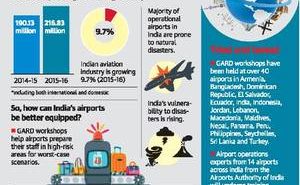 The scenes in the airport after a disaster is that the officials inundated with more to do than they have been trained to. Even though aid & relief workers know this, only Guwahati and chennai airports in India have been certified by the United Nations Development Programme (UNDP) as being disaster ready. To ensure more airports in India are prepared to cope with the necessary protocols and have the know-how to handle the rise in air traffic and flow of goods and people that typically follows a disaster, UNDP is currently conducting a Get Airports Ready for Disaster (GARD) programme training, hosted by Calicut International Airport. Representatives of 14 airports, including Mumbai, are participating. It is a part of Deutsche Port DHL Group (DPDHL) and UNDP expanding their internationally recognised programme to include officials and experts from the AAI. Evaluation of current level of preparedness, to conduct exercises, to develop specific recommendations and an action plan will be learnt by attendees. They can conduct GARD workshops at the National level themselves. Subhash Kumar, general manager, Airports Authority of India, said, “Whether it’s after Typhoon Haiyan in the Philippines, the recent massive twin earthquakes in Nepal, or a 2005-type deluge in Mumbai, airports often become vital hubs where terrified people seek a passage out, and where incoming aid is coordinated and distributed. More often than not, the high volume of relief goods and personnel, combined with the overall burden of the disaster, are more than many airports are equipped to handle. Channelling relief efforts from airports to affected communities requires efficient operational procedures, and appropriate infrastructure capabilities.”
The scenes in the airport after a disaster is that the officials inundated with more to do than they have been trained to. Even though aid & relief workers know this, only Guwahati and chennai airports in India have been certified by the United Nations Development Programme (UNDP) as being disaster ready. To ensure more airports in India are prepared to cope with the necessary protocols and have the know-how to handle the rise in air traffic and flow of goods and people that typically follows a disaster, UNDP is currently conducting a Get Airports Ready for Disaster (GARD) programme training, hosted by Calicut International Airport. Representatives of 14 airports, including Mumbai, are participating. It is a part of Deutsche Port DHL Group (DPDHL) and UNDP expanding their internationally recognised programme to include officials and experts from the AAI. Evaluation of current level of preparedness, to conduct exercises, to develop specific recommendations and an action plan will be learnt by attendees. They can conduct GARD workshops at the National level themselves. Subhash Kumar, general manager, Airports Authority of India, said, “Whether it’s after Typhoon Haiyan in the Philippines, the recent massive twin earthquakes in Nepal, or a 2005-type deluge in Mumbai, airports often become vital hubs where terrified people seek a passage out, and where incoming aid is coordinated and distributed. More often than not, the high volume of relief goods and personnel, combined with the overall burden of the disaster, are more than many airports are equipped to handle. Channelling relief efforts from airports to affected communities requires efficient operational procedures, and appropriate infrastructure capabilities.”







Leave a Reply